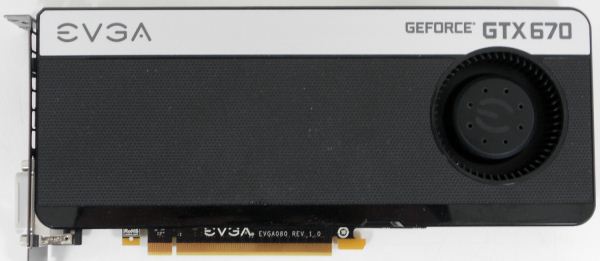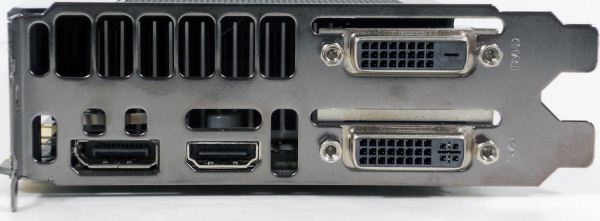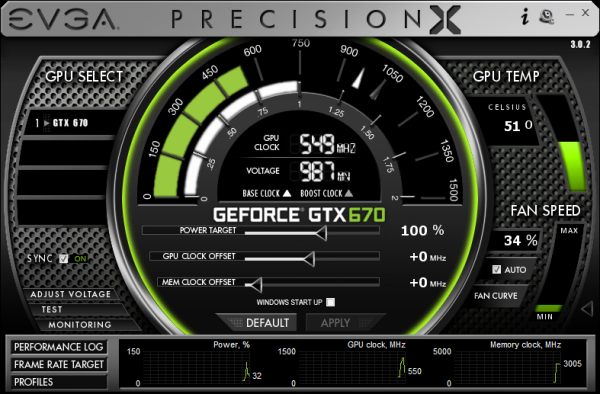NVIDIA GeForce GTX 670 Review Feat. EVGA: Bringing GK104 Down To $400
by Ryan Smith on May 10, 2012 9:00 AM ESTMeet The EVGA GeForce GTX 670 Superclocked
Our second card of the day is EVGA’s GeForce GTX 670 Superclocked, which in EVGA’s hierarchy is their first tier of factory overclocked cards. EVGA is binning GTX 670s and in turn promoting some of them to this tier, which means the GTX 670 Superclocked are equipped with generally better performing chips than the average reference card.
| GeForce GTX 670 Partner Card Specification Comparison | ||||
| EVGA GeForce GTX 670 Superclocked | GeForce GTX 670 (Ref) | |||
| CUDA Cores | 1344 | 1344 | ||
| Texture Units | 112 | 112 | ||
| ROPs | 32 | 32 | ||
| Base Clock | 967MHz | 915MHz | ||
| Boost Clock | 1046MHz | 980MHz | ||
| Memory Clock | 6210MHz | 6008MHz | ||
| Memory Bus Width | 256-bit | 256-bit | ||
| Frame Buffer | 2GB | 2GB | ||
| TDP | 170W | 170W | ||
| Manufacturing Process | TSMC 28nm | TSMC 28nm | ||
| Width | Double Slot | Double Slot | ||
| Length | 9.5" | 9.5" | ||
| Warranty | 3 Years | N/A | ||
| Price Point | $419 | $399 | ||
For the GTX 670 SC, EVGA has given both the core clock and memory clock a moderate boost. The core clock has been increased by 52MHz (6%) to 967MHz base and 66MHz (7%) boost to 1046MHz. Meanwhile the memory clock has been increased by 202MHz (3%) to 6210MHz.
Other than the clockspeed changes, the GTX 670 SC is an almost-reference card utilizing a reference PCB with a slightly modified cooler. EVGA is fabricating their own shroud, but they’ve copied NVIDIA’s reference shroud down to almost the last detail. The only functional difference is that the diameter of the fan intake is about 5mm less, otherwise the only difference is that EVGA has detailed it differently than NVIDIA and used some rounded corners in place of square corners.
The only other change you’ll notice is that EVGA is using their own high flow bracket in place of NVIDIA’s bracket. The high flow bracket cuts away as much metal as possible, maximizing the area of the vents. Though based on our power and temperature readings, this doesn’t seem to have notably impacted the GTX 670 SC.
While we’re on the matter of customized cards and factory overclocks, it’s worth reiterating NVIDIA’s position on factory overclocked cards. Reference and semi-custom cards (that is, cards using the reference PCB) must adhere to NVIDIA’s power target limits. For GTX 670 this is a 141W power target, with a maximum power target of 122% (170W). Fully custom cards with better power delivery circuitry can go higher, but not semi-custom cards. As a result the flexibility in building semi-custom cards comes down to binning. EVGA can bin better chips and use them in cards such as the Superclocked – such as our sample which can go 17 boost bins over the base clock versus 13 bins for our reference GTX 670 – but at the end of the day for stock performance they’re at the mercy of what can be accomplished within 141W/170W.
In any case, as the card is otherwise a reference GTX 670 EVGA is relying on the combination of their factory overclock, their toolset, and their strong reputation for support to carry the card. EVGA has priced the card at $419, $20 over the GTX 670 MSRP, in-line with other factory overclocked cards.
On the subject of pricing and warranties, since this is the first EVGA card we’ve reviewed since April 1st, this is a good time to go over the recent warranty changes EVGA has made.
Starting April 1st, EVGA has implemented what they’re calling their new Global Warranty Policy. Starting July 1st, 2011 (the policy is being backdated), all new EVGA cards ship with at least a 3 year warranty. And for the GTX 600 series specifically, so far EVGA has only offered models with a 3 year warranty in North America, which simplifies their product lineup.
To complement the 3 year warranty and replace the lack of longer term warranties, EVGA is now directly selling 2 and 7 year warranty extensions, for a total of 5 and 10 years respectively. So instead of buying a card with a 3 year warranty or a longer warranty, you’ll simply buy the 3 year card and then buy a warranty extension to go with it. However the extended warranty requires that the card be registered and the warranty purchased within 30 days.
The second change is that the base 3 year warranty no longer requires product registration. EVGA has other ways to entice buyers into registering, but they’ll now honor all applicable cards for 3 years regardless of the registration status. At the same time the base 3 year warranty is now a per-product warranty (e.g. a transferable warranty) rather than per-user warranty, so the base warranty will transfer to 2nd hand buyers. The extended warranties however will not.
The third change is how EVGA is actually going to handle the warranty process. First and foremost, EVGA is now allowing cards to be sent to the nearest EVGA RMA office rather than the office for the region the card was purchased from. For example a buyer moving from Europe to North America can send the card to EVGA’s North American offices rather than sending it overseas.
Finally, EVGA is now doing free cross shipping, alongside their existing Advanced RMA program. EVGA will now cross-ship replacement cards for free to buyers. The buyer meanwhile is responsible for paying to ship the faulty card back and putting up collateral on the new card until EVGA receives the old card.
There’s also one quick change to the step-up program that will impact some customers. With the move to purchasing extended warranties, the step-up program is only available to customers who either purchase an extended warranty or purchase an older generation card that comes with a lifetime warranty. Step-up is not available to cards with only the base 3 year warranty.
Moving on, along with EVGA’s new warranty EVGA is bundling the latest version of their GPU utilities, Precision X and OC Scanner X.
Precision X, as we touched upon quickly in our GTX 680 review, is the latest iteration of EVGA’s Precision overclocking & monitoring utility. It’s still based on RivaTuner and along with adding support for the GTX 600 series features (power targets, framerate caps, etc), it also introduces a new UI. Functionality wise it’s still at the top of the pack along with the similarly RivaTuner powered MSI Afterburner. Personally I’m not a fan of the new UI – circular UIs and sliders aren’t particularly easy to read – but it gets the job done.
OC Scanner X has also received a facelift and functionality upgrade of its own. Along with its basic FurMark-ish stress testing and error checking, it now also offers a basic CPU stress test and GPU benchmark.



















414 Comments
View All Comments
raghu78 - Thursday, May 10, 2012 - link
chew on thishttp://www.hardocp.com/article/2012/04/10/sapphire...
At 2560 x 1600 Ultra 4X MSAA the HD 7970 at 1050 Mhz will give you GTX 680 Perf. Pretty much same clock for clock.
just4U - Thursday, May 10, 2012 - link
I think some are missing the point here.. Don't matter right now, AMD or Nvidia both camps have excellent options. I know I'd trade my 6950 and 570s for either in a heart beat and throw in some cash as well..The only thing I can really find as a sticking point is price.. and while AMD may drop prices a little on the 7950 with the amount of ram it has and it's memory bandwidth I don't think it's going to get to the $300 mark. Maybe $350 though..
CeriseCogburn - Friday, May 11, 2012 - link
Wrong, nVidia has excellent options, amd has less than options.There you are, fixed for you.
CeriseCogburn - Thursday, May 10, 2012 - link
The 7970 loses at the same clocks.http://hexus.net/tech/reviews/graphics/37209-gefor...
Enjoy the reality.
will54 - Thursday, May 10, 2012 - link
Why compare clock speeds on two different architectures? It seems pointless especially when one of them has to be OC'd to get there.CeriseCogburn - Saturday, May 12, 2012 - link
Let's be honest, now with the GTX670 at $399 and available, the 7950 is a bad and hurtful joke, and the 7970 @ $479.99 w games is a joke too.Buy the game you want and the 670, forget the piece of crap amd cannot supply drivers properly for and in fact is a whomped loser in features, power, perf, triple monitor, monitor CONNECTIONS (not mentioned yet in this whole bloggery another nVidia advantage of the so many and too numerous to recall all at once)...
It's just a sad day for amd fanboys - it's a total stompage - I would be weeping and asleep if I were an amd fanboy - totally crushed, in need of verdetrol...
http://verdetrol.com/
That's what amd does with drivers coding money.. ROFL
CeriseCogburn - Friday, May 11, 2012 - link
That's quite the OC on their 4th amd 7970 sample - 1.35 volts, 1280 core and 7,455 memory - a quite unusual and generally on average unattainable, and unsustainable OC - run that puppy for a while and expect a quick burnout and housefire - not to mention the gigantic electric bill amd cost you.Then you'll want a free replacement for your fried $579 double X brastrap amd card, a free one..."no of course it wwasn't OC mr rma, I dunno what happened!?" -
---
Shady edge card destroying non 24/7 OC's don't count, not really. I wouldn't mind maybe 1050 or 1100 on the core, something one could expect to be sustained on flaky amd drivers with extra random dropout reboots multiple times daily...
eddman - Friday, May 11, 2012 - link
"AMD's 4XAA / 8X AA performance in Batman Arkham city has been fixed with the latest drivers.In fact in Batman Arkham city at 8X AA AMD is now faster ."Fair enough.
"In Shogun 2 Nvidia's performance has been hit severely due to the latest patch / driver situation and its clearly behind HD 7970 at 2560 x 1600 and 5760 x 1080."
So? If the latest patch messed up things, what it has to do with the card? They'll probably fix it with another patch.
"HD 7970 will easily defeat the GTX 680 given that HD 7970 1Ghz - 1.1 Ghz ( Sapphire HD 7970 Dual X, MSI HD 7970 Lightning (1070) , Powercolor PCS+ HD 7970 Vortex II (1100) ) is available in retail."
LOL, since when we compare OCed cards to competing non-OCed cards?
"The HD 7970 is a true single GPU beast with the raw power, memory bandwidth and size to handle the most demanding games of today and tomorrow. "
You sound like an AMD representative.
eddman - Friday, May 11, 2012 - link
"AMD's 4XAA / 8X AA performance in Batman Arkham city has been fixed with the latest drivers."Fair enough.
"In Shogun 2 Nvidia's performance has been hit severely due to the latest patch "
Which means it's a bug and will be fixed with another patch.
"HD 7970 will easily defeat the GTX 680 given that HD 7970 1Ghz - 1.1 Ghz ( Sapphire HD 7970 Dual X, MSI HD 7970 Lightning (1070) , Powercolor PCS+ HD 7970 Vortex II (1100) ) is available in retail."
Since when we compare OCed cards to competing stock cards?
"The HD 7970 is a true single GPU beast with the raw power, memory bandwidth and size to handle the most demanding games of today and tomorrow. "
Sorry, but that's something an AMD representative would say.
CeriseCogburn - Friday, May 11, 2012 - link
This is with just the amd 7970 overclocked all the way up to GTX680 stock speeds and the GTX680 left at stock speeds.http://hexus.net/tech/reviews/graphics/37209-gefor...
The 7970 still loses, and that's before the 680 is overclocked even 1mhz, while the 7970 is OC'ed to 1058 with 7970's memory OC'ed as well, and leaving the 680's memory at stock.
LOL - no amount of proofs will derail the zero point dark matter brain of the amd fanboy.